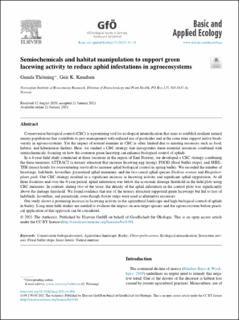| dc.description.abstract | Conservation biological control (CBC) is a promising tool for ecological intensification that aims to establish resilient natural enemy populations that contribute to pest management with reduced use of pesticides and at the same time support native biodiversity in agroecosystems. Yet the impact of natural enemies in CBC is often limited due to missing resources such as food, habitat, and hibernation shelters. Here, we studied a CBC strategy that incorporates these essential resources combined with semiochemicals, focusing on how the common green lacewing can enhance biological control of aphids. In a 4-year field study conducted at three locations in the region of East Norway, we developed a CBC strategy combining the three measures ATTRACT (a ternary attractant that increase lacewing egg laying), FOOD (floral buffer strips), and SHELTER (insect hotels for overwintering survival) to increase aphid biological control in spring barley. We recorded the number of lacewings, ladybirds, hoverflies, parasitized aphid mummies, and the two cereal aphid species Sitobion avenae and Rhopalosiphum padi. Our CBC strategy resulted in a significant increase in lacewing activity and significant aphid suppression. At all three locations and over the 4-year period, aphid infestation was below the economic damage threshold in the field plots using CBC measures. In contrast, during two of the years, the density of the aphid infestation in the control plots was significantly above the damage threshold. We found evidence that use of the ternary attractant supported green lacewings but led to loss of ladybirds, hoverflies, and parasitoids, even though flower strips were used as alternative resources. Our study shows a promising increase in lacewing activity in the agricultural landscape and high biological control of aphids in barley. Long-term field studies are needed to evaluate the impact on non-target species and the agroecosystem before practical application of this approach can be considered. | en_US |

